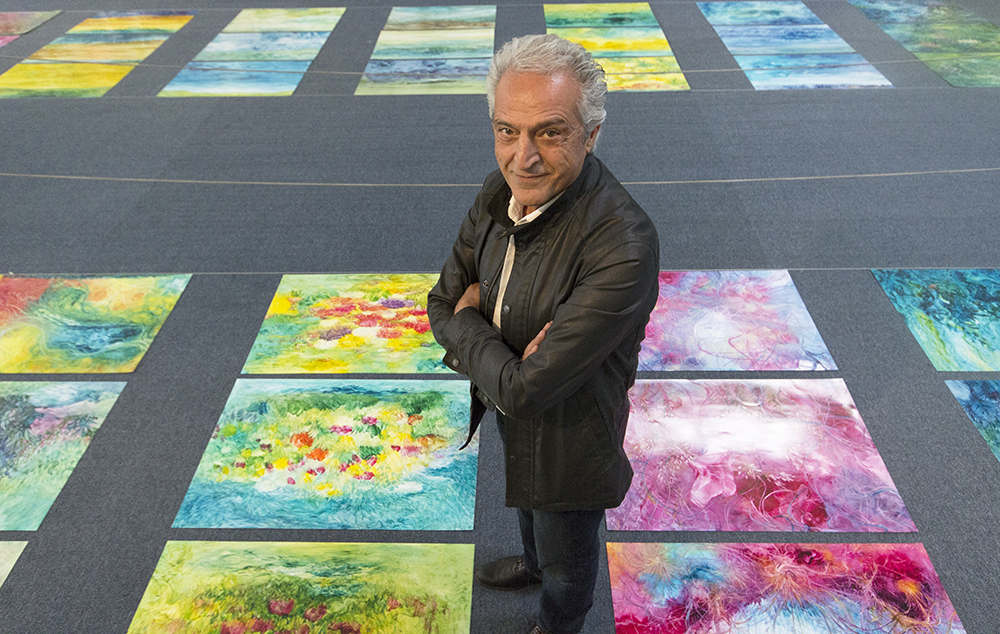Lead painter of abstract romanticism inspires art therapy research

Painter Kamran Khavarani, known for developing the art genre of abstract romanticism, displays his current gallery in Westwood, where visitors can walk through the gallery with 3-D glasses to fully experience Khavarani’s work.
By Natalie Chudnovsky
Nov. 27, 2013 12:01 a.m.
Kamran Khavarani created his own art genre, but he wasn’t sure what to name it. That’s why he called Albert Boime, a late UCLA art history professor, who later hailed Khavarani as the leader of a new artistic movement called “abstract romanticism.”
Khavarani is a decorated architect-turned-painter whose work has inspired research on art therapy and was the subject of Boime’s final book, “The Birth of Abstract Romanticism.”
Khavarani said the name “abstract romanticism” may seem like an oxymoron, but it describes his art perfectly. It has nearly no identifiable imagery and is non-narrative, and yet it’s emotionally evocative.
Khavarani doesn’t use a brush. Instead, he applies oil paints to paper directly with his hands. He said he now uses gloves so the paint doesn’t damage his skin.
“He paints with his palms,” said Victor Sagalovsky, a 3-D cinematographer who has been conducting research on Khavarani’s paintings. “He’s like a jazz musician. He studied all the rules of art and then he broke them.”
An untitled painting from Khavarani’s 2005 series, “Images from a Mystical world,” depicts a brown landscape against a dark blue sky. In the center, the brown and blues blur together in a fantastical shape. Khavarani said this represents the duality of spirituality and physicality and its connection within humans, which is a recurring theme in his work.
“Although they seem abstract, all the paintings evoke a deeper connection you have with the universe, even if you don’t recognize it consciously,” Sagalovsky said. “That’s why so many people who witness his paintings start crying. His paintings channel the human reflection of the divine.”
Khavarani was born in Iran, where he worked as an architect. After the Iranian Revolution, he immigrated to America where he turned more seriously to painting. Khavarani began studying mysticism and philosophy in America, and in 1999, he decided to use these themes in his art. He said he is heavily influenced by the works of 13th-century Persian poet Rumi.
But if he is ever called an artist, Khavarani will object vehemently.
“When people ask me if I’m an artist, I say I’m a painter,” Khavarani said. “I believe the word ‘artist’ has become misrepresented in the world of art.”
Khavarani believes Western artists focus on self-expression – something he calls “person art,” which is the opposite of real art, he said. Focusing on originality and giving something value just because it was done first is also damaging, according to Khavarani. He believes true art doesn’t express personal emotion but rather addresses universal themes and emotions. He distances himself from the word “artist” because it is tied to “person art.”

“He doesn’t paint when he’s anxious or depressed. He only paints when he’s in a state of joy,” Amirmostofian said. “There is a quality in his paintings which emanates positive energy.“
Khavarani’s works are currently on display in a gallery space in Westwood, where his paintings line the walls and floors. Visitors are encouraged to put on 3-D glasses as they walk through the gallery.
It was Amirmostofian who discovered that his paintings transform when viewed through 3-D glasses.
“I was working on a school project with my daughter and we had 3-D glasses. I put them on and when I looked at his art, I couldn’t believe how multilayered it was,” Amirmostofian said. “I started checking the other paintings in the house and nothing had the same effect.”
Both Amirmostofian and Sagalovsky are currently researching the therapeutic capacities of Khavarani’s art.
“I’m interested in 3-D as a therapeutic tool for the heart, for relaxation, for increasing neurotransmitters in the brain,” Sagalovsky said. “When I met Kamran, that’s what I found in his art.”
Amirmostofian said Khavarani’s paintings were donated to the Beverly Hills Cancer Center, where they have had a soothing influence on many patients.
Amirmostofian observed the reactions of random people who walked into the gallery and asked them to give her feedback. She said she would often find people meditating in front of a painting, and some wrote poetry after viewing the gallery.
Although currently most of the research has to do with recording the verbal reactions of gallery attendees, Amirmostofian and Sagalovsky hope to bring their work into the clinical sphere and examine people’s brains through functional magnetic resonance imaging.
“My goal is to create a curriculum of art therapy for the holistic person,” Sagalovsky said. “Khavarani’s paintings are non-invasive therapy. And in an age when everyone’s relying on antidepressants and drugs, this is what we need.”

